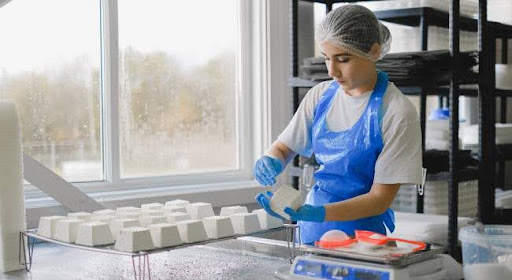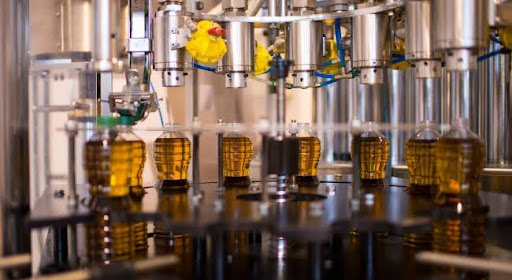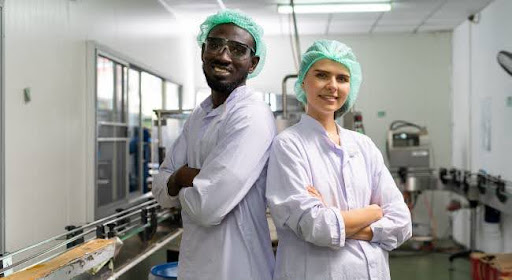
What Is Food Manufacturing Explained

Making food products can feel complex for many businesses. Food manufacturing turns raw ingredients into prepared food items we use daily. This blog explains how the food production process works and why it matters.
Key Takeaways
- Food manufacturing turns raw materials into safe, quality food products like bread, dairy, and frozen meals. It ensures safety through steps like processing, packaging, and quality checks.
- The industry evolved from ancient practices like drying to modern tools such as refrigeration and automation for faster production.
- Key processes include sourcing fresh ingredients, transforming them using machines or techniques like mixing or cooking, and distributing safely in sealed packages.
- Technologies like AI and robotics improve speed while ensuring consistent quality. Systems track safety with tools like metal detectors or x-rays during production.
- Challenges include high costs, strict regulations, contamination risks, labor shortages, and adapting to trends like plant-based foods while balancing eco-friendly practices.
Understanding the Food Manufacturing Process

Food manufacturing is the process of turning raw ingredients into edible products. It involves various steps to ensure safe, quality food for consumers.
Definition and Overview
Food manufacturing is the process of turning raw food materials into prepared food products for human consumption. It involves various steps, such as processing, packaging, and quality control, to produce safe and high-quality goods. This industry ensures that processed food products meet set food safety standards. From dairy products to frozen foods, manufacturers work on extending shelf life while maintaining taste and nutrition. The food supply chain depends heavily on this process to deliver reliable options to consumers worldwide.
Historical Evolution of Food Manufacturing
Food manufacturing has changed a lot over time. Early methods used simple tools to preserve food, like drying and salting. Ancient Egyptians stored grains in large structures to prevent spoilage. In the 19th century, the invention of canning transformed how people preserved food for long periods.
The Industrial Revolution played a big role in expanding food processing methods. Machines replaced manual labor, speeding up production. Later, inventions like refrigeration helped keep perishable items fresh during transport. Today’s advancements include automation and artificial intelligence, making processes faster and safer while meeting strict quality standards set by the food industry.
Key Stages of the Manufacturing Cycle
Food manufacturing includes several critical steps that ensure raw ingredients become the products we consume daily. Each stage plays a key role in maintaining quality, safety, and efficiency.
Raw Material Sourcing
Finding quality raw materials is a key step in food manufacturing processes. Food manufacturers need to source fresh, safe, and reliable ingredients. These materials impact the taste, safety, and shelf life of the final products.
Strong supply chain management helps ensure steady access to these resources. Working with trusted suppliers reduces risks like contamination or delays. This also supports efforts to improve food safety and meet strict food safety regulations.
Processing and Transformation
The step after sourcing raw materials is processing and transformation. This stage changes raw ingredients into ready-to-eat or packaged food products. Food processing companies often use methods like cutting, grinding, mixing, cooking, or freezing to convert raw materials.
This phase ensures the food meets quality standards and is safe for consumption. Automation and machinery speed up production while ensuring consistency in bulk manufacturing. Transforming raw ingredients also improves shelf life, reduces food waste, and enhances taste.
Ensuring food safety during this process is crucial for any business in the food manufacturing industry.
Packaging and Distribution
Packaging protects food and keeps it fresh. It uses packaging materials like glass, plastic, or metal to seal in quality. Clear labeling ensures consumers get vital details about the product—ingredients, expiration dates, and storage tips.
Distribution moves food efficiently from factories to stores or restaurants. Companies use trucks, ships, or planes to deliver products on time. Maintaining proper temperature during transit is key to ensure food safety and prevent spoilage.
Different Types of Food Manufacturing Methods
Food manufacturing comes in different forms based on processes and products. Each type plays a unique role in converting raw materials into finished goods.
Primary vs. Secondary Food Manufacturing
Primary food manufacturing involves converting raw materials into basic forms. For example, milling wheat into flour or extracting oil from seeds. These processes focus on preparing ingredients for further use.
Secondary food manufacturing transforms these ingredients into finished products. Baking bread from flour or making frozen pizza are examples. This step often includes packaging and quality control to ensure safe and appealing goods for consumers.
Examples by Industry Segment (e.g., dairy, baked goods, frozen foods)
Different industries handle food manufacturing differently. Each segment focuses on producing food products that meet consumer demands and ensure proper quality control measures.
- Dairy: This involves processing milk into cheese, yogurt, butter, and cream. It requires strict safety protocols to maintain freshness and avoid contamination.
- Baked Goods: This segment produces bread, cakes, cookies, and pastries. Automation helps improve efficiency in mixing, shaping, and baking these goods.
- Frozen Foods: These include ready-to-eat meals, frozen vegetables, and ice cream. Flash freezing technology preserves nutrients while extending shelf life.
- Beverages: This covers juices, sodas, water, and alcoholic drinks. Beverage production needs advanced filtration systems for consistency in taste.
- Meat Processing: Factories handle cutting, curing, or packaging of fresh meats like beef or chicken. They must follow hygiene regulations to prevent spoilage.
- Confectionery: Popular candies like chocolate bars or gummies come from this sector. Precision machinery ensures uniform shapes and sizes during production.
- Snacks: Chips, popcorn, and crackers are common in this industry. Producers focus on flavor innovation to attract more customers.
- Canned Foods: Items such as soups or canned fruits go through sealing processes for durability. Heat treatments ensure long-term storage without refrigeration.
Each industry tackles unique challenges but plays a big role in food and beverage manufacturing success!
Modern Technologies in Food Manufacturing
Technology plays a huge role in how food is made today. It helps improve speed, safety, and quality in every step of the process.
Automation and Machinery
Automation and machinery transform food manufacturing. Machines handle tasks like mixing, slicing, and cooking with speed. This reduces human effort while boosting efficiency and accuracy.
Robots sort products, pack items, or label packages quickly. Automated systems track production to ensure food quality stays consistent. Businesses save money by reducing waste and improving workflow.
Quality Control and Safety Systems
Modern machinery boosts production speed, but quality control ensures food stays safe. Systems like metal detectors and x-ray machines spot harmful items in products. Regular checks track temperature, hygiene, and ingredient integrity.
Strict safety measures protect consumers and brands. Follow guidelines like HACCP to reduce risks of contamination or spoilage. Investing in strong systems builds customer trust while meeting key industry regulations.
Food Manufacturing Regulations and Industry Standards
Food manufacturing follows strict rules to keep products safe and high-quality. These standards protect consumers and ensure businesses stay compliant.
Food Safety and Hygiene Regulations
Food safety rules protect both businesses and customers. These regulations ensure all food remains clean, safe, and free from harmful germs. Manufacturers must follow guidelines like proper storage temperatures, regular equipment cleaning, and pest control.
Employees should wash hands often, wear clean uniforms, and use gloves when handling raw items.
Hygiene also involves testing products for bacteria or other dangers. Regular audits check if companies meet standards like HACCP (Hazard Analysis Critical Control Point). Failure to comply can lead to fines or shut-downs.
Following these rules boosts consumer trust while reducing risks of recalls or health issues—key for strong marketing strategies in the industry!
Global and Regional Certification Standards
Global food certifications ensure consistent safety and quality. Standards like ISO 22000 or FSSC 22000 set rules for safe handling, processing, and storage of food. These help businesses meet international trade requirements while protecting consumers.
Regional certifications focus on local needs. For example, the USDA Organic label enforces strict organic farming practices in the U.S., while Europe’s BRCGS focuses on supply chain safety.
Adopting these shows commitment to both quality and customer trust.
Benefits and Common Challenges in Food Manufacturing

Food manufacturing boosts economies and meets consumer demands fast. Yet, it faces hurdles like high costs and strict regulations.
Economic and Consumer Benefits
Food manufacturing creates jobs and drives local economies. It supports farmers, suppliers, and transportation industries. In 2022, the global food market was worth over $8 trillion, showing how large its impact is.
For consumers, it offers convenience and variety. Processed foods stay fresh longer and are easier to store. Ready-to-eat meals save time for busy families. Safe packaging ensures quality while reducing waste.
These benefits improve daily life for millions worldwide.
Common Industry Challenges
Maintaining food safety is a major challenge. Contamination risks can occur at any stage, from sourcing to packaging. Strict regulations require constant monitoring and compliance, which can increase costs for businesses.
Equipment failures or improper handling may also lead to recalls, harming brand reputation.
Rising costs of raw materials and energy create financial pressures. Labor shortages in manufacturing facilities worsen the problem. Keeping up with changing consumer trends—like plant-based foods—requires rapid adaptation.
Balancing innovation while meeting deadlines adds more stress for companies in this competitive industry.
Emerging Trends in the Food Manufacturing Industry

Food manufacturing is changing fast as new ideas take over. Businesses now aim to balance efficiency with eco-friendly practices.
Sustainability and Eco-Friendly Practices
Reducing waste is key in food manufacturing. Many companies now recycle materials like cardboard and plastic from packaging. This cuts down on landfill use and saves resources.
Energy-efficient machines also help lower carbon footprints. Some factories have switched to solar or wind power, reducing reliance on fossil fuels. Small changes add up over time, benefiting both businesses and the planet.
Innovation and Smart Manufacturing
Smart manufacturing uses advanced technology to improve food production. Automation plays a big role, helping machines handle tasks faster and more accurately than people can. Sensors monitor every step, ensuring consistent quality and safety.
AI and robotics are changing the game for food businesses. AI predicts demand, reduces waste, and optimizes production schedules. Robotics streamline complex processes like sorting or packaging.
These tools save time, cut costs, and boost efficiency—key benefits in today’s competitive market.
Final Thoughts on the Future of Food Manufacturing
Food manufacturing plays a big role in how we eat today. It turns raw ingredients into tasty, safe, and convenient products. With new technology and smart practices, it keeps evolving to meet demand.
It’s all about feeding the world efficiently!
Frequently Asked Questions About Food Manufacturing
1. What is food manufacturing?
Food manufacturing is the process of turning raw ingredients into finished products that people can eat or drink. It includes steps like cleaning, cooking, packaging, and storing food.
2. Why is food manufacturing important?
It ensures that food is safe to eat, lasts longer on shelves, and meets quality standards. It also helps produce large amounts of food to meet consumer demand.
3. What are common methods used in food manufacturing?
Common methods include mixing, freezing, drying, pasteurizing, and canning. These processes help preserve foods and improve their taste or texture.
4. How does technology impact food manufacturing?
Technology improves efficiency by automating tasks like sorting ingredients or packaging products. It also helps maintain safety by monitoring production for contamination risks.




